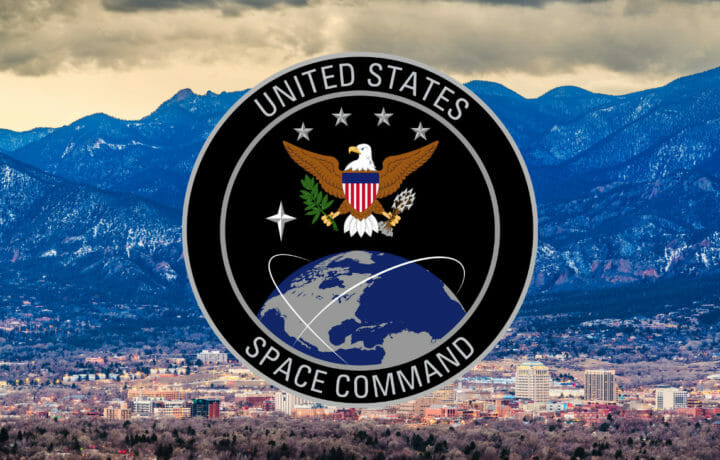The head of the United States Space Command announced that the nation’s 11th and newest combatant command had achieved full operational capability. SPACECOM has the staff, infrastructure, and plans it will need to handle the mission of conducting space operations, while it can protect American and allied assets and interest in space.
The United States Space Command was established in 2019 in Colorado, to monitor space activity and threats, support other military units with space capabilities like communications and surveillance, respond to crises involving space, deter aggression, and defeat enemies if needed.
The announcement followed the preliminary declaration of Initial Operational Capability on Aug. 24, 2021.
“Since its establishment in 2019, USSPACECOM has been singularly focused on delivering exquisite capability to the joint force to deter conflict, defend our vital interests, and, if necessary, defeat aggression,” said U.S. Army Gen. James Dickinson, who heads up the U.S. Space Command.
“Thanks to the disciplined initiative of our people and the support of our joint, combined and partnered team, I can confidently say we have reached full operational capability,” Dickson added, following an in-depth evaluation of the command’s capabilities, to include the ability to execute its mission on what he said could include “our worst day, when we are needed the most.”
According to SPACECOM that criteria included accomplishing the Unified Command Plan mission alongside global campaigning, exercising, and responding to crises; having the right numbers of skills across the human capital; having the infrastructure needed to support command and control across mission and business functions; having the necessary command processes and functions in place; and being able to set the conditions and requirements for the future fight.
“As the command has matured, challenges to a safe, secure, stable, and sustainable space domain have significantly increased,” Dickinson noted. “Both the People’s Republic of China and the Russian Federation are fielding counter space capabilities designed to hold U.S., Allied and partner space assets at risk. And North Korea and Iran are in the early stages of developing their space enterprise.”
In addition to being competitive and contested, the space domain has become increasingly congested with an increase in commercial activity, and the concern of space debris, which has increased by 76% since 2019 to 44,600 objects, SPACECOM noted. This has presented unique challenges that have already motivated and focused the command to prepare to counter threats in, to, and from space. Already over the last four years the command’s competence has been refined and validated through real-world events and exercise scenarios.
One Challenge Remains – SPACECOM’s Permanent HQ
It is notable that SPACECOM has been declared of full operational capability, yet doesn’t seem to be any closer to seeing the debate over its permanent headquarters resolved.
It was in July that President Joe Biden said that the headquarters would remain at Peterson Space Force Base, Colorado Springs, reversing plans made under former President Donald Trump to move it to Redstone Arsenal, in Huntsville, Alabama.
Lawmakers in Alabama, including Rep. Mike Rogers, who serves as the chairman of the House Armed Services Committee, have continued the push to relocate SPACECOM to Redstone.
The walls may be closing in on those efforts, however, as Colorado lawmakers have argued that by reaching FOC, moving the HQ could set back the command in terms of readiness.
Yet, compromise language in the 2024 National Defense Authorization Act passed last week bars Space Command from spending money on a new Colorado Springs headquarters building until further investigation of the current basing decision is completed.
The Road to FOC
It was only in 2019 that the command rapidly established a 24/7 Joint Operations Center, the focal point for command and control of all friendly and threatening activities in the domain that also facilitates the flow of information needed to accomplish assigned missions. Since that time, the JOC has monitored, tracked, and reported a significant number of space activities, enabling timely notification of critical information for decisions by national leaders.
This has most notably included Russia’s direct-ascent anti-satellite missile test in November 2021, which generated more than 1,500 pieces of orbital debris and drew global condemnation for the long-lasting threat to the domain.
SPACECOM can now provide combatant commanders with space capabilities in support of theater operations, including weather monitoring; space control; intelligence, surveillance, and reconnaissance; position, navigation, and timing; satellite communications; and missile warning.
While the FOC declaration is an important milestone, it does not mean the command will stop developing capability or capacity. The command, like all others, will require additional resources to keep pace with competitors and evolving threats, SPACECOM also made clear.
“Our work continues. As the complexity of the domain grows, so must our capability to deliver operational and strategic effects to our nation and preserve the safety and stability of the domain,” Dickinson continued. “Thank you to the Department of Defense, the Department of the Air Force as our Combatant Command Support Agent, to Congress, and to our Colorado Springs community for their continued support of our mission and our service members and their families. I’m incredibly proud of the men and women of USSPACECOM for their commitment to ensure there is never a day without space.”




